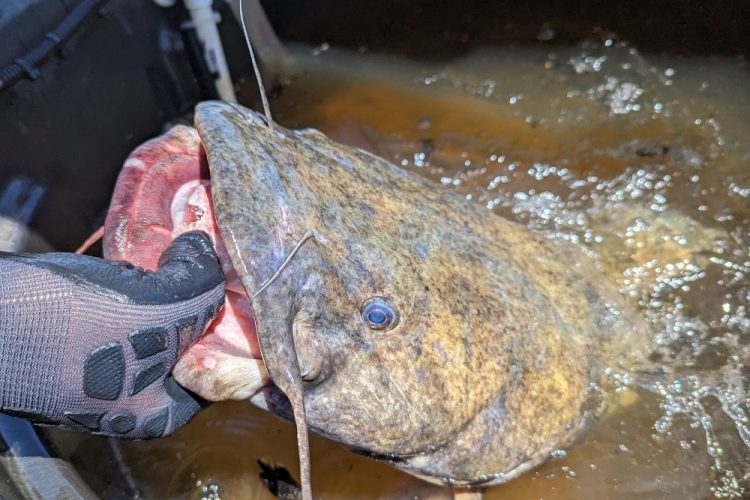To determine what the flathead catfish were eating, researchers collected 576 of them over two years,
with 241 individuals having recoverable stomach contents. The researchers extracted DNA from those contents
to identify what the fish were eating. (Keith Sutton photo)
Flathead Catfish Impacting Susquehanna’s Food Chain
Source: Penn State News
Study’s findings may lead to better management strategies as these large, hungry predators continue spreading throughout the basin.
Flathead catfish, native to the Mississippi River basin, were first found in Pennsylvania’s Susquehanna River in 2002, according to the U.S. Geological Survey. In the years since, these fish have spread widely throughout the river system. Scientists are now starting to understand their diet and how they impact the river’s ecosystem.
A team of researchers from Penn State, the Pennsylvania Fish and Boat Commission, the U.S. Fish and Wildlife Service, and the U.S. Geological Survey recently studied flathead catfish in the Susquehanna River. Their findings, published in Transactions of the American Fisheries Society, show how these large predators are changing the river’s food chain. Known to grow over four feet long and weigh up to 70 pounds, flatheads eat many different species and can greatly reduce native fish populations.
“We wanted to find out how this invasive species is affecting the ecosystem and which species are most at risk,” said Megan Schall, a biology professor at Penn State Hazleton and a study coauthor. “Flathead catfish can be very harmful to aquatic communities where they don’t naturally belong.”
The researchers studied 576 flathead catfish over two years, using electrofishing, hoop nets, and fish collected from the Conowingo Dam fish lift. They found 241 fish with stomach contents they could analyze. By using DNA testing, they identified 47 prey species, including rusty crayfish, shiners, and margined madtoms, a small catfish species of conservation concern. Other prey included smallmouth bass, gizzard shad, rock bass, white perch, and even other flathead catfish.
The study revealed that larger flatheads eat bigger prey. Fish under 24 inches long ate a mix of invertebrates and small fish, while larger ones mostly ate fish. This feeding behavior threatens both recreationally important species, like walleye and smallmouth bass, and ecologically sensitive species, such as blueback herring.
“Knowing what flatheads are eating helps us understand their impact on the river,” said Schall. “This information is key to finding ways to manage this invasive predator.”
Flathead catfish are expanding their range in the Susquehanna River, and their presence raises big challenges for native species and ecosystems. Julian Avery, the research team leader, noted that these fish were likely introduced to the river by humans. “The damage they can cause to ecosystems is huge,” Avery said. “We’re just starting to see how serious their impact is.”



